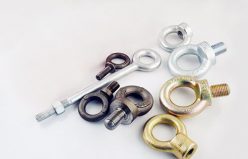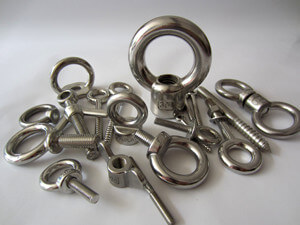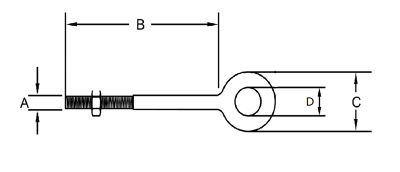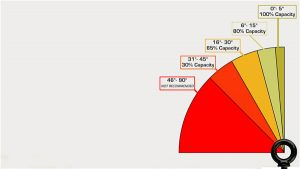A Complete Buying Guideline of Eye Bolts
What are eye bolts?
Eye bolts are one of the most used in applications where the load is pulled away from the eye or toward the eye in material handling. They feature the simplest design but made from forged steel that has been quenched and tempered, commonly consisting of a threaded shank with a ring or eye at one end, can be threaded to structures such as wood, steel or concrete, and often lock by a nut. They are designed to create a lifting eye through rope, cable, or shackles that can be secured for their safe working load.

Type of eye bolts
Eye bolts are available in a range of sizes, materials and finishes, from small eye bolts to large eye bolt, but commonly there are five main types of eye bolts, include regular eye bolt, shoulder type eye bolt, lag eye screw, forged eye bolt, and stainless steel eye bolts.
Regular Eye Bolt
Regular eye bolt is a non-shouldered eye bolt with a nut, it is designed to be inserted through a hole and secured on the backside with the provided nut. It can only be used for completely vertical straight line straight line pulls or supporting an overhead load only. It will bend and break if loaded at the side or angular loading, so it is not recommended for angular loading. For angular lifts, shoulder eye bolts are the better choice.

Shoulder Eye Bolt
Shoulder eye bolt is also known as collared eye bolt, features a supporting shoulder or collar to provide more stability to the base of the eye, so that can be loaded with slings at angles or with any kind of angular loading, but the capacity will be lost at different angles loading, and make sure that the shoulder eye bolt is installed properly. If the shoulder is not completely flush, it can only be used for vertical lifts, equal to regular eye bolt. We can offer long shank collared eye bolt, and machinery eye bolt, called shoulder pattern machinery eye bolt, features a shoulder with shank, fully threaded shank but without a secured nut. It is designed to be screwed directly into threaded or tapped holes, used as a connection point in rigging applications.

- Lag eye screw is also known as lag screw eye bolt, which is a kind of eye bolts for wood, they are designed for screwing into the thimbles. So, they don’t have a working load limit assigned to them because they are not possible to determine the various densities and conditions of the wood the eye bolts are screwed into.

Forged eye bolt
Forged eye bolts come complete with a drop-forged eye, and feature good hardness and strength can be used in heavy-duty lifting applications.
They are made from high tensile carbon steel, forged and annealed, making them higher thermal conductivity, lower melting point, more malleability and durability, and better heat distribution than stainless steel, perfect for heat treatment, ideal for cold weather applications, and maintain the structural integrity and performance even in cold environments.
Then they are anodized, hot-dip galvanised, or plated (gold, zinc, or tin) even phosphate coating finishes, which can effectively prevent corrosive substances from coming into contact with the carbon steel, and improve corrosion resistance.

Stainless Steel Eye Bolts
Stainless steel eye bolts have a high chromium content that forms an invisible layer on the steel to prevent corrosion, due to this reason stainless eye bolts will endure longer in decking, architectural and marine applications since their high polished finish compared with galvanized carbon steel eye bolts.

How are eye bolts measured?
The best way to understand eye bolt is from the eye bolt sizes, it should be taken from directly underneath the eye, for there are different types in the lengths of the shank. The image below shows markings and specifications that are common across all types of eye bolts.

- Shank diameter (thread) (A)
- length of the shank (B)
- Exterior eye diameter (C)
- Interior eye diameter (D)
- Overall length (E)
The diameter of the shank (A) and length of the shank (B) is the most important aspect for eye bolts because they will infect the working load limit and thickness of the material that the eye bolt will be installed into.
Please see the eye bolt size chart as per your need from our eye bolt and nut catalog.
How to calculate eye bolt capacity?
The eye bolts are available in various working load limit to lift different weights. So it is important not to exceed eye bolt capacity, which refers to the load a single eye bolt can lift when the load is applied through the shank of the eye bolt vertically.
As the sling angle occurs at any other angle, the eye bolt capacity begins to diminish. The greater the angle the more drastically the rated capacity is reduced. It is very important that riggers understand the angular loading of lifting eye bolt capacity chart to make their lift safely:
- 5 degrees 100% of working load limit
- 15 degrees 80% of working load limit
- 30 degrees 65% of working load limit
- 45 degrees 30% of working load limit
- 46+ degrees Not recommended

How to install eye bolts?
The correct installation of eye bolts is same important as choosing eye bolt, here are some tips for installation:
- Check the thickness of the material, then choose the right the eye bolt with enough length to go through.
- Tighten the nut make the eye bolt firmly seated and keep the eye bolt shoulder flush against the mating surface.
- Use steel washers to fill the space of the unthreaded part of the shank, but the thickness of the steel washer must not exceed one thread pitch.
We hope this article can help you with the selection and installation of eye bolts. If you’re interested in learning more about the eye bolts, please Contact Us today.







